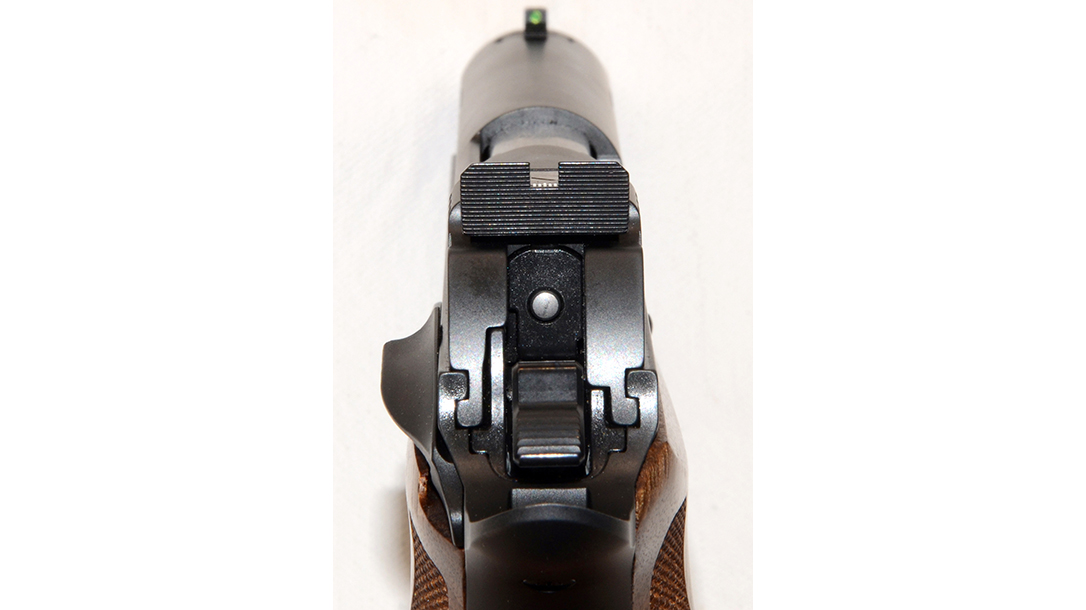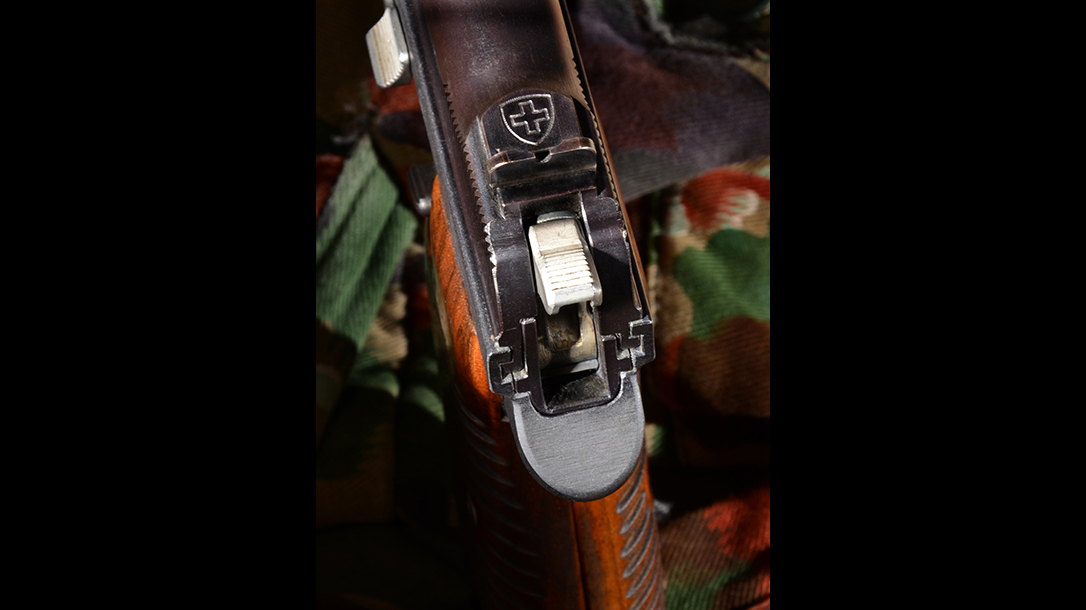Switzerland’s historic policy of armed neutrality has always been enforced by citizen soldiers capable of defending their country’s mountainous terrain with their marksmanship abilities. As a result, the Swiss have put great emphasis on the quality of their weapons. As soldiers typically stayed in the army for decades after completing their initial service and took their weapons home with them, Swiss small arms were not only designed to be accurate but also durable. Upon completion of reserve service, many Swiss soldiers purchased their weapons and continued to shoot in the many rifle and pistol matches throughout Switzerland.
Often, the weapons were passed from father to son and continued to be shot generation after generation. I had one friend in Switzerland who became an officer in the Swiss army shortly after the 9mm Sig Sauer P220 was adopted as the P75 to replace the P210. In addition to his pistol, he also inherited his grandfather’s Swiss Luger and his father’s SIG P210 pistols.
Advertisement — Continue Reading Below
Prior to World War II, the Swiss army began searching for a replacement for the Luger pistol. One requirement was that it chamber the 9x19mm cartridge rather than the 7.65x21mm round used in the Swiss Luger. In 1937, Schweizerische Industrie Gesellschaft (SIG) licensed the Petter design used in the French M1935 pistol. SIG engineers improved upon this design, resulting in the SP47/8 pistol. Among the innovative design features in the SP47/8 was the use of full-length external rails on the slide mated with full-length internal rails on the frame. This enhanced slide alignment has contributed to the SIG design’s excellent accuracy.
Most importantly for a pistol that would serve the Swiss army, the SP47/8, despite and because of the tight tolerances, proved highly reliable. Also noteworthy in the SP47/8’s design was the modular hammer unit that could lifted out of the frame when the slide was removed to allow for lubrication or access to the hammer spring.
Classic P210
The SP47/8’s accuracy standard held that the gun had to group five shots into 2 inches at 50 meters using Swiss military-issued PP41 match-grade 9mm ammunition. That standard of accuracy continued for later versions of the SP47/8 throughout its production. In addition to the slide/frame matchup, the SP47/8’s accuracy was also a result of the high-quality steel barrel and crisp trigger.
Advertisement — Continue Reading Below
Officially adopted by the Swiss army in 1949, the pistol was designated the P49, with military pistols having a serial number with an “A” prefix. The PP41 was adopted as the standard Swiss army cartridge. Initially, civilian versions of the pistol were designated the SP47/8, but in the 1950s that was changed to P210, the designation by which it is best known.
Details
For a pistol that has attained such iconic status, the P210/P49 has a very basic design, especially by contemporary standards. It has a single-stack, eight-round magazine, fixed sights, a single- action trigger and a heel-mounted magazine release. Compared to many contemporary combat pistols with more modern actions and double-stack magazines, not to mention ambidextrous frame-mounted magazine releases, the P210 seems pretty retro. However, I would note that the P210 is not a “spray and pray” pistol. It’s designed for shooters who can take advantage of its accuracy, in some cases to engage at a distance beyond that easily obtainable by modern “wondernines.”
Accuracy
That longer-distance accuracy is what first drew me to the P210. I was working on close-protection details in some pretty dangerous places and wanted a pistol that would let me engage an attacker, especially one armed with a rifle or submachine gun, at 50 to 100 yards. I switched from carrying two Browning Hi-Powers to a single Hi-Power and a SIG P210. And I realize that went against the conventional wisdom that backup pistols should use the same magazines. However, I carried a 13-round magazine in my Browning and had two spare 20-round magazines of the type used by the SAS. For my P210, I carried three 8-round magazines. Speaking of magazines, I should note that I only used Swiss-made factory P210 magazines—no aftermarket ones. Original SIG mags always been expensive and somewhat hard to find.
Advertisement — Continue Reading Below
I never could shoot my P210 to the “2 inches at 50 meters” standard, but I could get 2-inch groups at 25 meters on a good day, which is as well as I did with any other pistol. More importantly, I could shoot the P210 at 50 meters better than any other pistol I owned, and I could keep half of my shots or better on a silhouette target at 100 meters.
Enter The P210 Target
In 2005, the Neuhausen branch of Sig Sauer ceased production of the P210. I felt a sense of loss, even though I knew that my P210 would outlast me. However, in 2010, Sig Sauer introduced the P210 Legend, which was made in Germany. Most of the features of the P210 were retained, though the bottom magazine release was replaced by a frame-mounted button. This definitely sped up the reloading process. I also found the wooden grips on the Legend fatter than those on my P210, but they were still comfortable. The Legend also had an extended beavertail for those who had problems with hammer bite. I tested the Legend and found it accurate and reliable. I was glad that a P210 was available for those who wanted one, even if it wasn’t made in Neuhausen.
The next logical step was to produce the P210 here in the U.S., and in January of 2016, Sig Sauer announced that it would begin production of the P210 in Exeter, New Hampshire. It took some time, but I recently got my hands on the P210 Target model and have been shooting it ever since.
Advertisement — Continue Reading Below
This is a P210, but not quite the P210 that I have become accustomed to. It still has the external slide rails and internal frame rails, the hammer group still is removable, and the trigger pull is still quite good. The slide has roughly the same shape, but it is slightly different. The frame-mounted safety of the P210 Legend is retained, but in a more convenient location farther back—think Colt 1911. This is a certainly an improvement in ease of operation.
More Details
The grips on the P210 Target are oversized, thus requiring a thick slam pad on the magazine. I can’t say the grips are uncomfortable; they’re just big. Since I have always used the P210 as a carry gun, I’ve had to adjust to the grips a bit. But don’t get me wrong: They’re actually comfortable for shooting.
Advertisement — Continue Reading Below
And I have been shooting the P210. I have taken it to the range three times and put at least 100 rounds through it each time. On one occasion a friend, also a P210 fan, was with me and put another 100 rounds or so through it. With somewhere between 400 and 500 rounds through it without a single cleaning, the gun still functions flawlessly. That’s the level of reliability I expect from a P210, or any SIG for that matter.
For accuracy tests, my friend and I each fired five-shot groups at 25 yards with five different types of ammo. I took the best group with each load, no matter who shot it. And the pistol’s accuracy was remarkably consistent, with all shots falling between 2.3 and 3 inches. Then my friend set up a police training silhouette at 100 yards and fired five Federal 115-grain FMJs to create a 9.5-inch group. During another session, I fired nine rounds at a similar silhouette at 100 yards and hit it six times. I also shot at plates at 100 yards, hitting a bit over half the time.
Parting Shots
As you can see, the P210 Target is quite accurate. It has some ergonomic improvements, and the sights combine with the trigger pull and tight tolerances to make for a very accurate pistol. Also, compared to the prices of used Swiss-made P210s, the MSRP of $1,699 should appeal to shooters who want to own a new P210. Plus, spare magazines will be available for a more reasonable price than they have typically been.
Advertisement — Continue Reading Below
I’m not always a believer that newer is better. I really like my classic SIG P210 and certainly plan to keep shooting it. However, I am also not a believer that newer is worse—it’s just different. I like the idea that a version of the legendary P210 is available for a new generation of shooters, especially since it’s made right here in the U.S.
Sig Sauer P210 Target Specs
| Caliber: 9mm |
| Barrel: 5 inches |
| OA Length: 8.4 inches |
| Weight: 36.9 ounces (empty) |
| Grip: Walnut |
| Sights: Fiber optic, adjustable |
| Action: SA |
| Finish: Nitron |
| Capacity: 8+1 |
| MSRP: $1,699 |
Sig Sauer P210 Target Performance
| Load | Accuracy |
|---|---|
| Black Hills 115 EXP JHP | 2.69 |
| Black Hills 124 JHP | 2.50 |
| Federal 115 FMJ | 2.38 |
| Sig Sauer 124 FMJ | 2.75 |
| Winchester 147 FMJ | 3.00 |
*Bullet weight measured in grains and accuracy in inches for best five-shot groups at 25 yards.
For more information, visit sigsauer.com.
Advertisement — Continue Reading Below
This article was originally published in the May/June 2018 issue of “Combat Handguns.” To order a copy and subscribe, visit outdoorgroupstore.com.
































